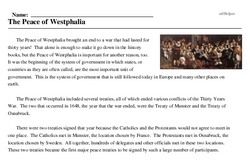The Peace of Westphalia
The Peace of Westphalia brought an end to a war that had lasted for thirty years! That alone is enough to make it go down in the history books, but the Peace of Westphalia is important for another reason, too. It was the beginning of the system of government in which states, or countries as they are often called, are the most important unit of government. This is the system of government that is still followed today in Europe and many other places on earth.
The Peace of Westphalia included several treaties, all of which ended various conflicts of the Thirty Years War. The two that occurred in 1648, the year that the war ended, were the Treaty of Munster and the Treaty of Osnabruck.
There were two treaties signed that year because the Catholics and the Protestants would not agree to meet in one place. The Catholics met in Munster, the location chosen by France. The Protestants met in Osnabruck, the location chosen by Sweden. All together, hundreds of delegates and other officials met in these two locations. These two treaties became the first major peace treaties to be signed by such a large number of participants.
The terms of the treaties were complicated. The Holy Roman Empire had not surrendered at the end of the war but rather had been worn down by years and years of fighting. Many of the other countries were tired of fighting, too. So the treaties included many compromises.
Another issue that led to the need for compromises was the length of the war. Over the course of thirty years, many changes had taken place in the warring countries. Some countries had even changed sides. The peace treaty had to somehow find a compromise that took all of this into account and, at least in part, please each of the countries involved.




